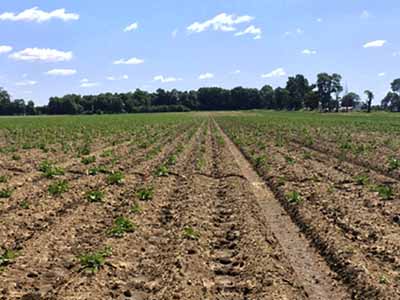Blackleg and tuber soft rot disease reported in some Michigan potato fields
In the past few weeks blackleg has been found in several Michigan potato fields. Similar to last year’s growing season, potato aerial stem rot, blackleg and tuber soft rot disease continue to be a problem.

Aerial blackleg and tuber soft rot of potato have been reported in several locations throughout the state. Tuber soft rot results in rotting tissue that is mushy, slimy and water-soaked (Photo 1). Soft rot of the potato seed piece can occur following planting and cause poor emergence or create foliar symptoms (Photo 2). The disease was not a major issue in the United States until a recent outbreak during the 2015 growing season. During 2015, a wet June resulted in a high incidence of aerial stem rot in parts of Michigan. Blackleg, aerial stem rot and tuber soft rot are caused by either the bacteria Dickeya spp. or Pectobacterium spp. (formerly classified in the genus Erwinia). Potato plants exhibiting blackleg symptoms from different fields were submitted to the Michigan State University Diagnostic Services laboratory for pathogen identification. Biological and culture based approaches, and subsequent DNA analysis by the Potato and Sugarbeet Pathology Laboratory, identified both Dickeya dianthicola and Pectobacterium atrosepticum in the submitted samples. Confirmed infected varieties were Norwis and Lamoka.
The first step in effective disease management of potato is accurate identification and diagnosis. Effective culture and DNA-based detection methods are available for Dickeya and Pectobacterium. Visually, Dickeya and Pectobacterium cause similar symptoms. Because of these similarities, it is recommended that growers send a sample of a plant with a suspected pathogen to a diagnostics lab such as MSU Diagnostic Services for accurate identification.
For more information on disease symptoms, the disease cycle and post-harvest management strategies, refer to the MSU Extension bulletin E-3335 “Tuber Soft Rot, Blackleg and Aerial Stem Rot.”

Photo 2. Symptoms of tuber soft rot and blackleg caused by Dickeya dianthicola result in a field with poor emergence.
Dr. Rosenzweig’s work is funded in part by MSU’s AgBioResearch.



 Print
Print Email
Email


